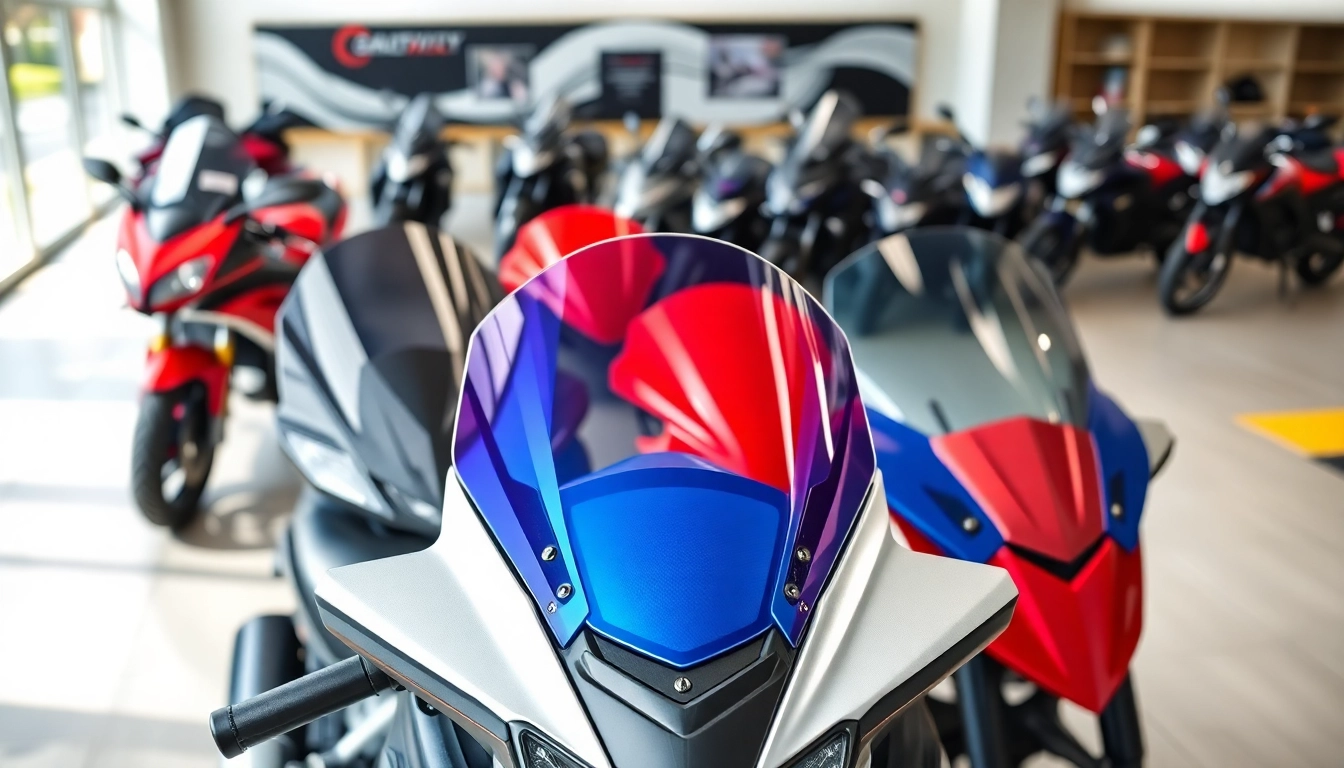Understanding Motorcycle Windscreens
What are Motorcycle Windscreens?
Motorcycle windscreens, often referred to as windshields, are transparent panels installed on the front of the motorcycle. Their primary function is to deflect wind, rain, and debris away from the rider, enhancing comfort and visibility during rides. These screens come in various shapes and sizes to cater to different motorcycle types and riding styles. They can be constructed from materials such as acrylic, polycarbonate, or glass, each offering unique advantages in terms of durability, weight, and protection.
Benefits of Using Motorcycle Windscreens
The benefits of motorcycle windscreens extend beyond mere comfort. They play a pivotal role in rider safety, aerodynamics, and ergonomics. Here are some significant advantages:
- Wind Protection: Windscreens help block strong winds, reducing fatigue during long rides.
- Debris Protection: They safeguard riders from flying debris such as bugs and stones, which can cause injuries or distract the rider.
- Improved Aerodynamics: A well-designed windscreen can reduce drag, enhancing speed and fuel efficiency.
- Aesthetic Appeal: Windscreens can enhance the overall look of a motorcycle, allowing riders to express their style.
- Comfort Enhancements: They can contribute to a more comfortable riding posture by reducing turbulence around the rider.
Different Types of Motorcycle Windscreens
Motorcycle windscreens vary significantly based on their shape, size, and design. Here are some common types:
- Full-Sized Windscreens: Typically found on touring motorcycles, these offer maximum wind protection.
- Sport Windscreens: Designed to be sleek and aerodynamically efficient, these are common on sport bikes.
- Cruiser Windscreens: Often smaller and customizable, these windscreens add style while providing moderate protection.
- Universal Windscreens: These are adjustable to fit various models, making them a flexible option for many riders.
Selecting the Right Motorcycle Windscreen
Factors to Consider When Choosing
Choosing the right motorcycle windscreen requires careful consideration of various factors:
- Motorcycle Type: The style and model of your motorcycle affect the compatibility and functionality of the windscreen.
- Riding Style: Depending on whether you ride on the highway or prefer local commuting, your windscreen needs will differ.
- Height and Body Shape: Your physical dimensions play a role in how effective the windscreen will be in maximizing comfort.
- Material Preference: Preferences for glass, acrylic, or polycarbonate should be based on durability, weight, and clarity.
How to Measure for Your Motorcycle
Measuring for the right windscreen is crucial for achieving the best fit. Follow these steps:
- Height Measurement: Measure from the bottom of the headlight to the top of the windshield mounting points.
- Width Measurement: Measure the width of the motorcycle’s handlebars to ensure compatibility.
- Angle Measurement: Assess the angle at which the windscreen will be mounted to optimize aerodynamics and rider protection.
Material Guide: Glass vs. Plastic Windscreens
In selecting materials for motorcycle windscreens, glass and plastic each have specific advantages and disadvantages:
- Glass: Known for its optical clarity and resistance to scratching, glass windscreens provide superior durability but are heavier and more prone to breaking.
- Plastic (Acrylic/Polycarbonate): Lighter and flexible, these materials are less prone to shattering but can scratch more easily. Some manufacturers apply special coatings to enhance scratch resistance.
Installation Guide for Motorcycle Windscreens
Step-by-Step Installation Process
Installing a motorcycle windscreen can be a straightforward task if approached systematically. Follow these general steps:
- Gather Materials: Ensure you have all necessary components including bolts, brackets, and appropriate tools.
- Prepare the Motorcycle: Clean the mounting area thoroughly to avoid scratches.
- Install Brackets: Fit the mounting brackets to the motorcycle according to the manufacturer’s instructions.
- Attach the Windscreen: Align the windscreen with the installed brackets and secure it using provided fasteners.
- Final Adjustments: Make necessary adjustments for optimal position and check for stability before riding.
Common Tools Needed
Having the right tools on hand is vital for a smooth installation. Common tools include:
- Socket Wrench
- Phillips and Flat Head Screwdrivers
- Allen Key Set
- Tape Measure
- Cleaning Cloth
Tips for a Secure Fit
To ensure a secure and safe fit of your motorcycle windscreen, consider the following tips:
- Check the manufacturer’s instructions for specific mounting requirements.
- Do not overtighten bolts to avoid cracking the windscreen.
- Regularly inspect the windscreen after installation for any signs of wear or loosening.
Maintenance Tips for Motorcycle Windscreens
Cleaning and Care Best Practices
Maintaining your motorcycle windscreen is essential for longevity and visibility. Follow these cleaning and care practices:
- Use a soft, lint-free cloth to clean the surface.
- Avoid window cleaners with ammonia; instead, use products specifically designed for plastic or glass.
- Regularly rinse off road grime and debris to prevent scratching.
How to Remove Scratches
Despite your best efforts, scratches can occur. Here are some effective methods for removing them:
- For Acrylic Windscreens: Use a plastic polish to buff out minor scratches. Apply with a soft cloth and rub in circular motions.
- For Glass Windscreens: A glass polishing compound can help remove light surface scratches.
When to Replace Your Windscreen
Knowing when to replace your windscreen is vital for safety and performance. Signs that it may need replacing include:
- Deep or widespread scratches that impair visibility.
- Cracks that could worsen with vibrations or impacts.
- Deformation or warping that affects the windscreen’s shape and effectiveness.
Enhancing Performance with Motorcycle Windscreens
Impact on Aerodynamics and Speed
Motorcycle windscreens have a profound effect on aerodynamics. An appropriately designed windscreen helps in minimizing drag and turbulence, which can significantly improve performance and speed. By creating a smoother airflow over the rider’s body, it allows for better handling at high speeds and can lead to enhanced fuel efficiency.
Safety Features to Look For
When choosing a windscreen for safety, consider the following features:
- Impact Resistance: Look for materials that offer high resistance to impacts, particularly for off-road or high-speed applications.
- UV Protection: Windscreens with UV coatings protect the rider from harmful rays while preventing material degradation.
- Optical Clarity: Ensure that the windscreen maintains clear visibility even in various light conditions.
Comparative Analysis: Top Brands and Models
Reviewing brands and models is crucial when investing in motorcycle windscreens. Leading brands, such as Zero Gravity and National Cycle, offer a range of products tailored for performance and durability:
- Zero Gravity: Known for precision engineering, they offer innovative designs like the Double Bubble that promise enhanced aerodynamics.
- National Cycle: Features the Quantum® hardcoating that provides scratch resistance and superior clarity.
- Memphis Shades: Providing vast selections cater to style preferences for various motorcycle types.
In conclusion, investing in quality motorcycle windscreens is essential for safety, comfort, and performance. Understanding their benefits, how to select the right one, maintain it properly, and recognize its impact on your bike’s performance will undoubtedly enhance your riding experience.



